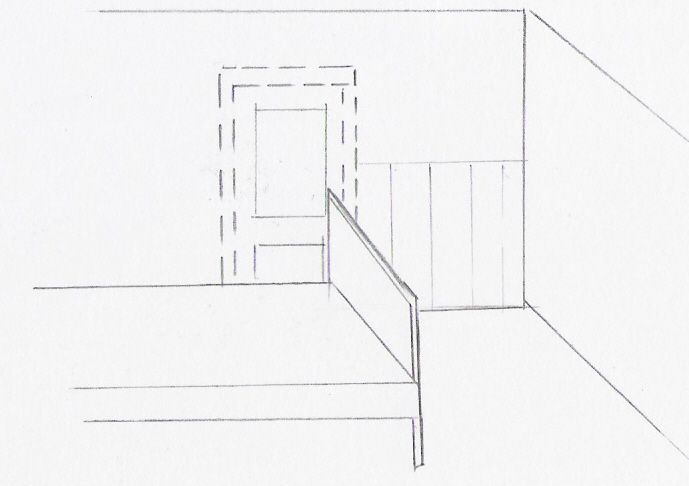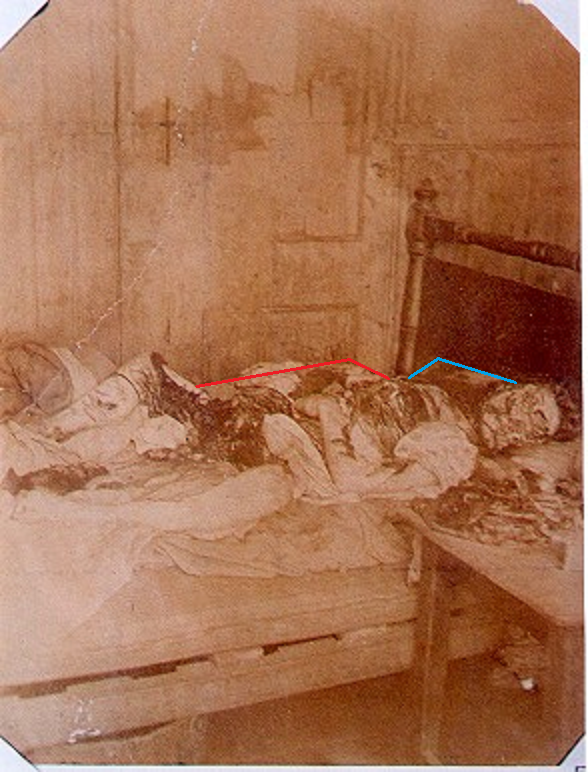Originally posted by Wickerman
View Post
Prater's stairs
Collapse
X
-
Ha! thanks for the feedback.
So.... at this point which plan (discounting my attempt) has the most merit?
Goad or Thomas or is there an alternative?
Oh! also:
The side door (Prater's); is that an original part of the house?Last edited by richardh; 12-21-2015, 08:33 AM.
Leave a comment:
-
Hello Richard.Originally posted by richardh View PostI've assumed the stairs (non-blue ones) are original.

Thoughts?
If the grey stairs are original, then the blue stairs are a later addition?
So the question remains, what purpose does constructing a second set of stairs serve that was not already served by the original set?
Now a second question arises.
What purpose did that side door serve if there were no 'blue' stairs originally?
From the point of view of a landlord in a low-income area, expensive renovations are to be avoided.
It is far more cost effective to remove/rework a wooden partition, and install or move a door here or there, than to build two sets of stairs that lead to the same landing.
With respect to the problem of Prater seeing light through Kelly's partition as Prater ascends the stairs, maybe the stairs were of open construction, only treads with no risers, like this:

Prater could then see through as she goes up the stairs.
Leave a comment:
-
Originally posted by Wickerman View PostYes, Dorset St. is 25ft wide, but what scale are you measuring at?
For instance, the scale on the map is 40ft = 1 inch.
Brushfield St. is 40ft wide (property line to property line).
Have you printed this out so that Brushfield St. is 1 inch wide, in order to set your scale?
Hi Wickerman,
You donīt need any scale. With this formula you can calculate any length or width on the map. The calculation is based on relativity.
The only thing you need to start is knowledge of the width of the street.
Zoom the map of Dorset Street as much as you like. Put a ruler over the street where the notation 25 ft is. Measure how many centimeters you have. Divide 7,62 m (25 ft) with the sum of centimeters, you get a measure X.
Use the ruler to take a measure Y which is a wall, a doorway, or a passage. The map must have the same size as when you took the measure.
Multiply Y with X.
Regards Pierre
Leave a comment:
-
This is an alternative plan I've duly called the Harris Plan! (that's me)
It is probably way off but it solves lots of problems (and probably creates a few!)
Blue is Prater's door and steps which were added to the existing building.
I've created a sort of Hanbury St. configuration from the front door which would have gone down a hall right up to and into the door/partition of #13
I've assumed the stairs (non-blue ones) are original.
On the upper floor we have a full width landing so that #19 & #20 doors face each other
The store room is in the right place and right size
Prater's steps are just treads like the steps in Dutfield's Yard. (if they were a later addition then i would suggest they were just wooden steps rather than full-blown stairs).
The #13 partition would be visible to anyone ascending the 'Prater steps'.

Thoughts?
Leave a comment:
-
Richard, just returning to this previous rendition for a moment.Originally posted by richardh View PostJon
Here is a revise of the view from Prater's stairs regarding the corner, as per Hanbury st. stairs and hall configuration to show more of the partition:

thoughts?
If this wall between the brown 'door' and the corner of Kelly's room was 2.5ft, then are you saying the stairs running up the side wall from that side passage door (Praters door) are only 2.5ft wide?
Those stairs appear to meet Kelly's wall in the space we are talking about, but on the other side of the wall.
Leave a comment:
-
Ok Richard, at least you tried it.Originally posted by richardh View PostWell, at 5 ft the partition is completely hidden by the wall & Prater's stairs as you ascend. This is not looking good!

In your opinion, was the 2.5 ft distance between the brown 'door' and the corner of the room (as you previously had it), sufficient to address the distance between the headboard and the passage wall (out of view) in the photograph?
It's hard to estimate the width of those wainscoting panels, but 8-9 inches each might be a reasonable approximation. That alone would suggest roughly 24-27 inches of space behind the headboard, and likely a little more.
Some press reports have a washstand in that corner, behind the bed.
Thanks for trying.
Leave a comment:
-
Partition starts about 2.5ft from passage wall. Should I make it 5 ft ?

Originally posted by Wickerman View PostHi Richard.
Ok, thanks, now if you rotate the view so we can see that brown door? in Kelly's wall, from roughly the middle of her larger room window, a view something like this;

In the photo of the 'body-on-the-bed' we can see wainscoting behind the headboard extending away into the corner of the room, but the corner is out of the picture.

See how far her bed is away from the passage wall behind the headboard?
At least three wooden wainscoting panels, maybe more.
I'm suspicious that you have that brown door too close to the passage wall.
(Hope that is not too confusing)
(Ignore the coloured lines)
Leave a comment:
-
Hi Richard.
Ok, thanks, now if you rotate the view so we can see that brown door? in Kelly's wall, from roughly the middle of her larger room window, a view something like this;

In the photo of the 'body-on-the-bed' we can see wainscoting behind the headboard extending away into the corner of the room, but the corner is out of the picture.

See how far her bed is away from the passage wall behind the headboard?
At least three wooden wainscoting panels, maybe more.
I'm suspicious that you have that brown door too close to the passage wall.
(Hope that is not too confusing)
(Ignore the coloured lines)Last edited by Wickerman; 12-20-2015, 06:04 PM.
Leave a comment:
-
Jon,
Like this?

Doors now about 12 ft apart. Although I'm now not sure about that alcove I created to expose more partition. To get to that part you would hit your head going under the stairs. Of course I could always adjust the wall length etc.
On a positive note Prater would be seeing the corner of that partition close up on ascending the stairs.
Originally posted by Wickerman View Post
Just a question, could the stairs that we see run up from that side door be shorter in depth?
I mean, if you came down from the upper floor 3 or 4 steps, then turn at 90 deg. maybe three? steps, then descend to the side door, would that reduce the depth of the stairs allowing the side door to come nearer towards Kelly's room?
(Recall the stairs at Hanbury St?)
I'm sorry, I don't have AutoCad anymore, otherwise I would do it myself.
Leave a comment:
-
Wow Richard. This is really looking good. Well done!Originally posted by richardh View PostJon
Here is a revise of the view from Prater's stairs regarding the corner, as per Hanbury st. stairs and hall configuration to show more of the partition:

thoughts?
Leave a comment:
-
Wonderful Richard!Originally posted by richardh View PostJon
Here is a revise of the view from Prater's stairs regarding the corner, as per Hanbury st. stairs and hall configuration to show more of the partition:

thoughts?
This is really taking shape.
Just a question, could the stairs that we see run up from that side door be shorter in depth?
I mean, if you came down from the upper floor 3 or 4 steps, then turn at 90 deg. maybe three? steps, then descend to the side door, would that reduce the depth of the stairs allowing the side door to come nearer towards Kelly's room?
(Recall the stairs at Hanbury St?)
I'm sorry, I don't have AutoCad anymore, otherwise I would do it myself.
Leave a comment:

Leave a comment: